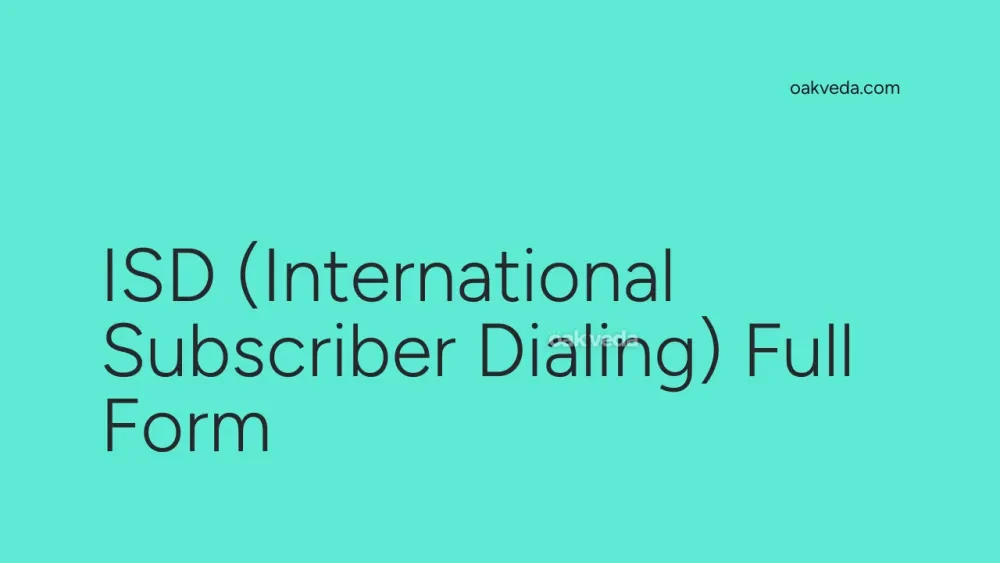
What is the Full Form of ISD?
The full form of ISD is International Subscriber Dialing. This term is widely used in the telecommunications industry to describe a system that allows telephone users to directly dial international calls without the assistance of an operator.
What is International Subscriber Dialing?
International Subscriber Dialing, commonly known as ISD, is a service that enables telephone users to make international calls directly from their devices. It eliminates the need for operator assistance, making long-distance communication more efficient and accessible. ISD is also referred to as International Direct Dialing (IDD) in some regions.
Origin and Development of International Subscriber Dialing
The concept of ISD has its roots in the mid-20th century when telecommunications technology began to advance rapidly. Here's a brief timeline of its development:
- 1957: The first transatlantic direct dial telephone call was made by Sally Reed in Dedham, Massachusetts, to her penpal, Ann Morsley, in Dedham, Essex.
- Late 20th century: ISD became widely available, revolutionizing international communication.
- Present day: ISD continues to evolve with advancements in digital and mobile technologies.
How does International Subscriber Dialing work?
ISD operates on a standardized system of country codes and area codes. Here's how it functions:
- Each country is assigned a unique ISD code.
- To make an international call, the user dials:
- The international exit code (e.g., 00 or 011)
- The country code of the destination
- The area code and local number
For example, to call a number in the United Kingdom from the United States, you would dial: 011 (US exit code) + 44 (UK country code) + area code + local number.
Functions of International Subscriber Dialing
ISD serves several crucial functions in global telecommunications:
- Direct international calling: Enables users to make international calls without operator assistance.
- Standardization: Provides a uniform system for international dialing across different countries.
- Efficiency: Reduces the time and resources required for international communication.
- Accessibility: Makes international calling available to a broader range of users.
Applications of International Subscriber Dialing
ISD has numerous applications in both personal and professional contexts:
- Business communication: Facilitates international business calls and conferences.
- Personal connections: Allows individuals to stay in touch with friends and family abroad.
- Emergency services: Enables international emergency calls when traveling.
- Global customer support: Supports businesses in providing customer service across borders.
Features of International Subscriber Dialing
ISD comes with several key features that make it an essential part of modern telecommunications:
- Universal accessibility: Available in most countries worldwide.
- Integration with mobile networks: Works seamlessly with cellular phones.
- Compatibility with VoIP: Functions with internet-based calling services.
- Automatic routing: Directs calls through the most efficient international pathways.
Benefits of International Subscriber Dialing
The introduction of ISD has brought numerous benefits to users worldwide:
- Convenience: Eliminates the need to go through operators for international calls.
- Cost-effectiveness: Generally more affordable than operator-assisted calls.
- Speed: Allows for quick and direct international connections.
- Privacy: Provides a more private calling experience compared to operator-assisted calls.
- 24/7 availability: Enables international calling at any time, regardless of time zone differences.
Limitations or Challenges of International Subscriber Dialing
Despite its advantages, ISD does face some challenges:
- Cost variations: International call rates can vary significantly between providers and countries.
- Technical issues: Network congestion or technical failures can affect call quality.
- Complexity: Some users may find the dialing process confusing, especially with different country codes.
- Fraud concerns: ISD can be vulnerable to international calling scams and fraud.
Future Developments in International Subscriber Dialing Technology
As telecommunications technology continues to evolve, so does ISD. Some potential future developments include:
- Integration with 5G networks: Improving call quality and connection speeds.
- Enhanced fraud prevention: Implementing advanced security measures to protect users.
- Simplified dialing processes: Developing more user-friendly systems for international calling.
- Integration with AI assistants: Using voice commands to place international calls more easily.
FAQs on ISD Full Form
-
What is the difference between ISD and STD? ISD (International Subscriber Dialing) is for international calls, while STD (Subscriber Trunk Dialing) is for long-distance calls within a country.
-
Do all countries use the same ISD codes? No, each country has its unique ISD code, but the system for using these codes is standardized globally.
-
Can I use ISD on my mobile phone? Yes, most mobile phones support ISD, but you may need to activate international calling with your service provider.
-
Is there an alternative to using ISD codes? Yes, many internet-based calling services and apps allow international calls without using traditional ISD codes.
-
How do I find the ISD code for a specific country? You can find ISD codes online, in phone directories, or by contacting your telephone service provider.
International Subscriber Dialing has transformed the way we communicate globally, making international calls more accessible and efficient. As technology continues to advance, we can expect ISD to evolve, further improving our ability to connect across borders.
You may be interested in:

